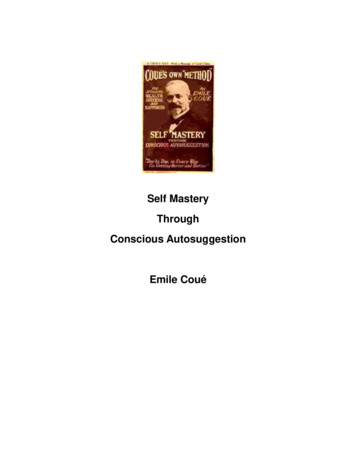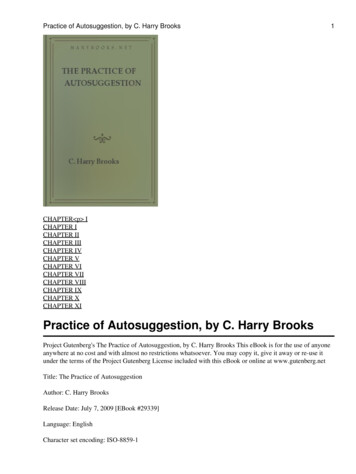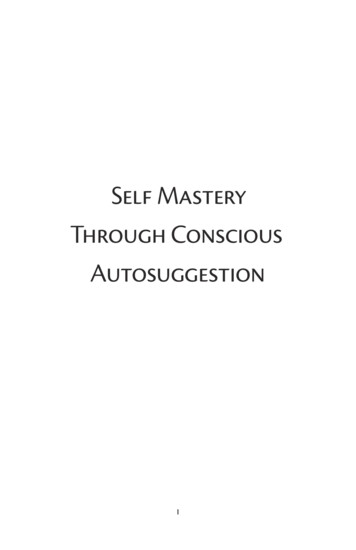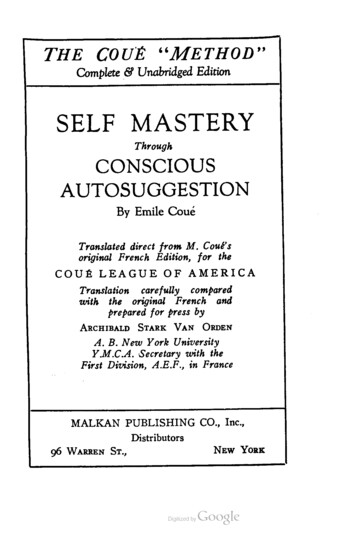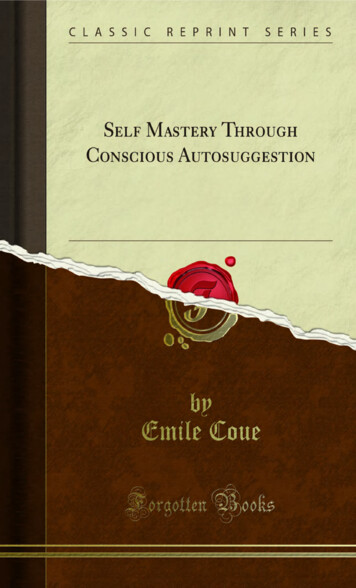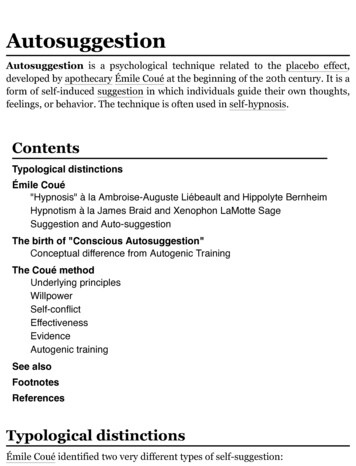
Transcription
AutosuggestionAutosuggestion is a psychological technique related to the placebo effect,developed by apothecary Émile Coué at the beginning of the 20th century. It is aform of self-induced suggestion in which individuals guide their own thoughts,feelings, or behavior. The technique is often used in self-hypnosis.ContentsTypological distinctionsÉmile Coué"Hypnosis" à la Ambroise-Auguste Liébeault and Hippolyte BernheimHypnotism à la James Braid and Xenophon LaMotte SageSuggestion and Auto-suggestionThe birth of "Conscious Autosuggestion"Conceptual difference from Autogenic TrainingThe Coué methodUnderlying nceAutogenic trainingSee alsoFootnotesReferencesTypological distinctionsÉmile Coué identified two very different types of self-suggestion:
intentional, "reflective autosuggestion": made by deliberate and consciouseffort, andunintentional, "spontaneous auto-suggestion": which is a "naturalphenomenon of our mental life which takes place without conscious effort[and has its effect] with an intensity proportional to the keenness of [our]attention".[1]In relation to Coué's group of "spontaneous auto-suggestions", his studentCharles Baudouin (1920, p. 41) made three further useful distinctions, basedupon the sources from which they came:"Instances belonging to the representative domain(sensations, mental images, dreams, visions, memories, opinions, and allintellectual phenomena).""Instances belonging to the affective domain(joy or sorrow, emotions, sentiments, tendencies, passions).""Instances belonging to the active or motor domain(actions, volitions, desires, gestures, movements at the periphery or in theinterior of the body, functional or organic modifications)."Émile CouéÉmile Coué, who had both B.A. and B.Sc. degrees before he was 21, graduatedtop of his class (with First Class Honours) with a degree in pharmacology fromthe prestigious Collège Sainte-Barbe in Paris in 1882.[2] Having spent anadditional six months as an intern at the Necker-Enfants Malades Hospital inParis, he returned to Troyes, where he worked as an apothecary from 1882 to1910.[3]"Hypnosis" à la Ambroise-Auguste Liébeault and HippolyteBernheimIn 1885, his investigations of hypnotism and the power of the imaginationbegan with Ambroise-Auguste Liébeault and Hippolyte Bernheim, two leadingexponents of "hypnosis",[4] of Nancy, with whom he studied in 1885 and 1886(having taken leave from his business in Troyes). Following this training, "hedabbled with ‘hypnosis’ in Troyes in 1886, but soon discovered that theirLiébeault's techniques were hopeless, and abandoned ‘hypnosis’ altogether".[5]
Hypnotism à la James Braid and Xenophon LaMotte SageIn 1901, Coué sent to the United States for a free book, Hypnotism as It is (i.e.,Sage, 1900a),[6] which purported to disclose "secrets [of the] science that bringsbusiness and social success" and "the hidden mysteries of personal magnetism,hypnotism, magnetic healing, etc.". Deeply impressed by its contents, hepurchased the French language version of the associated correspondence course(i.e., Sage, 1900b, and 1900c),[7] created by stage hypnotist extraordinaire,"Professor Xenophon LaMotte Sage, A.M., Ph.D., LL.D., of Rochester, NewYork" (who had been admitted into the prestigious Medico-Legal Society ofNew York in 1899).In real life, Xenophon LaMotte Sage was none other than Ewing Virgil Neal(1868-1949), the multi-millionaire, calligrapher, hypnotist, publisher,advertising/marketing pioneer (he launched the career of Carl R. Byoir),pharmaceutical manufacturer, parfumier, international businessman, confidantof Mussolini, Commandatore of the Order of the Crown of Italy, Officer of theLegion of Honour, and fugitive from justice, who moved to France in the1920s.[8]Sage's course supplied the missing piece of the puzzle — namely, Braid-stylehypnotic inductions — the solution for which had, up to that time, eluded Coué:"Coué immediately recognised that the course’s Braid-style ofhypnotism was ideal for mental therapeutics. He undertook anintense study, and was soon skilled enough to offer hypnotismalongside his pharmaceutical enterprise. In the context ofLiébeault’s ‘hypnosis’, Braid’s hypnotism, and Coué’s (later)discoveries about autosuggestion, one must recognise thesubstantially different orientations of Liébeault’s "suggestivetherapeutics", which concentrated on imposing the coercive powerof the operator’s suggestion, and Braid’s "psycho-physiology", whichconcentrated on activating the transformative power of the subject’smind."[9][10]Although he had abandoned Liébeault's "hypnosis" in 1886, he adopted Braid'shypnotism in 1901; and, in fact, in addition to, and (often) separate from, hisauto-suggestive practices, Coué actively used Braid's hypnotism for the rest ofhis professional life.[11]
Suggestion and Auto-suggestionCoué was so deeply impressed by Bernheim's concept of “suggestivetherapeutics” — in effect, "an imperfect re-branding of the ‘dominant idea’theory that Braid had appropriated from Thomas Brown"[5][12] — that, on hisreturn to Troyes from his (1886-1886) interlude with Liébeault and Bernheim,he made a practice of reassuring his clients by praising each remedy's efficacy.He noticed that, in specific cases, he could increase a medicine's efficacy bypraising its effectiveness. He realized that, when compared with those to whomhe said nothing, those to whom he praised the medicine had a noticeableimprovement (this is suggestive of what would later be identified as a "placeboresponse")."Around 1903, Coué recommended a new patent medicine, based onits promotional material, which effected an unexpected and immediatecure (Baudouin, 1920, p.90; Shrout, 1985, p.36). Coué (the chemist)found “[by subsequent] chemical analysis in his laboratory [that there was]nothing in the medicine which by the remotest stretch of the imaginationaccounted for the results” (Shrout, ibid.). Coué (the hypnotist) concludedthat it was cure by suggestion; but, rather than Coué having cured him,the man had cured himself by continuously telling himself the same thingthat Coué had told him."[13]The birth of "Conscious Autosuggestion"Coué discovered that subjects could not be hypnotized against their will and,more importantly, that the effects of hypnotic suggestion waned when thesubjects regained consciousness. He thus eventually developed the Couémethod, and released his first book, Self-Mastery Through ConsciousAutosuggestion (published in 1920 in England and two years later in the UnitedStates). He described autosuggestion itself as:“. an instrument that we possess at birth, and with which we playunconsciously all our life, as a baby plays with its rattle. It ishowever a dangerous instrument; it can wound or even kill you ifyou handle it imprudently and unconsciously. It can on thecontrary save your life when you know how to employ itconsciously.[14]”
Although Coué never doubted pharmaceutical medicine, and still advocated itsapplication, he also came to believe that one's mental state could positivelyaffect, and even amplify, the pharmaceutical action of medication. He observedthat those patients who used his mantra-like conscious suggestion, "Every day,in every way, I'm getting better and better", (French: Tous les jours, à touspoints de vue, je vais de mieux en mieux; lit. 'Every day, from all points of view,I'm getting better and better') — in his view, replacing their "thought of illness"with a new "thought of cure", could augment their pharmaceutical regimen inan efficacious way.Conceptual difference from Autogenic TrainingBy contrast with the conceptualization driving Coué's auto-suggestive selfadministration procedure — namely, that constant repetition creates a situationin which "a particular idea saturates the microcognitive environment of 'themind' ", which, then, in its turn, "is converted into a corresponding ideomotor,ideosensory, or ideoaffective action, by the ideodynamic principle of action","which then, in its turn, generates the response"[15][16] — the primary target ofthe entirely different self-administration procedure developed by JohannesHeinrich Schultz, known as Autogenic Training, was to affect the autonomicnervous system, rather than (as Coué's did) to affect 'the mind'.The Coué methodLa méthode CouéContinuously, unjustly, and mistakenly trivialised as just a hand-clasp, someunwarranted optimism, and a ‘mantra’, Coué’s method evolved overseveraldecades of meticulous observation, theoretical speculation, in-the-fieldtesting,incremental adjustment, and step-by-step transformation.It tentatively began (c.1901) with very directive one-to-one hypnoticinterventions, based upon the approaches and techniques that Coué hadacquiredfrom an American correspondence course.
As his theoretical knowledge, clinical experience, understanding ofsuggestion and autosuggestion, and hypnotic skills expanded, it graduallydeveloped into its final subject-centred version—an intricate complex of(group) education, (group) hypnotherapy, (group) ego-strengthening, and(group) training in self-suggested pain control; and, following instructioninperforming the prescribed self-administration ritual, the twice dailyintentionaland deliberate (individual) application of its unique formula, "Every day,inevery way, I’m getting better and better".Yeates (2016c), p.55.The Coué method centers on a routine repetition of this particular expressionaccording to a specified ritual, in a given physical state, and in the absence ofany sort of allied mental imagery, at the beginning and at the end of each day.Coué maintained that curing some of our troubles requires a change in oursubconscious/unconscious thought, which can only be achieved by using ourimagination. Although stressing that he was not primarily a healer but one whotaught others to heal themselves, Coué claimed to have affected organic changesthrough autosuggestion.[17]Underlying principlesCoué thus developed a method which relied on the belief that any ideaexclusively occupying the mind turns into reality,[18] although only to theextent that the idea is within the realm of possibility. For instance, a personwithout hands will not be able to make them grow back. However, if a personfirmly believes that his or her asthma is disappearing, then this may actuallyhappen, as far as the body is actually able to physically overcome or control theillness. On the other hand, thinking negatively about the illness (e.g. "I am notfeeling well") will encourage both mind and body to accept this thought.Willpower
Coué observed that the main obstacle to autosuggestion was willpower. For themethod to work, the patient must refrain from making any independentjudgment, meaning that he must not let his will impose its own views onpositive ideas. Everything must thus be done to ensure that the positive"autosuggestive" idea is consciously accepted by the patient, otherwise one mayend up getting the opposite effect of what is desired.[19]Coué noted that young children always applied his method perfectly, as theylacked the willpower that remained present among adults. When he instructed achild by saying "clasp your hands" and then "you can't pull them apart" thechild would thus immediately follow his instructions and be unable to unclasptheir hands.Self-conflictCoué believed a patient's problems were likely to increase if his willpower andimagination opposed each other, something Coué referred to as "self-conflict."As the conflict intensifies, so does the problem i.e., the more the patientconsciously wants to sleep, the more he becomes awake. The patient must thusabandon his willpower and instead put more focus on his imaginative power inorder to fully succeed with his cure.EffectivenessWith his method, which Coué called "un truc,"[20] patients of all sorts wouldcome to visit him. The list of ailments included kidney problems, diabetes,memory loss, stammering, weakness, atrophy and all sorts of physical andmental illnesses. According to one of his journal entries (1916), he apparentlycured a patient of a uterus prolapse as well as "violent pains in the head"(migraine).[21]EvidenceAdvocates of autosuggestion appeal to brief case histories published by ÉmileCoué describing his use of autohypnosis to cure, for example, enteritis andparalysis from spinal cord injury.[22]
Autogenic trainingAutogenic training is an autosuggestion-centered relaxation techniqueinfluenced by the Coué method. In 1932, German psychiatrist Johannes Schultzdeveloped and published on autogenic training. Unlike autosuggestion,autogenic training has been proven in clinical trials and, along with otherrelaxation techniques, such as progressive relaxation and meditation, hasreplaced autosuggestion in therapy. The co-author of Schultz's multi-volumetome on autogenic training, Wolfgang Luthe, was a firm believer that autogenictraining was a powerful approach that should only be offered to patients byqualified professionals. Its effectiveness has been confirmed in severalstudies.[23][24]See alsoBehavioral confirmationÉmile CouéInner criticIntrapersonal communicationMind–body interventionsMind-wanderingNancy SchoolThe Salpêtrière School of HypnosisSelf-defeating prophecySelf-fulfilling yThink aloud protocolThomas theoremVisual thinkingFootnotes1. Baudouin (1920), pp.33-34.
2. Yeates (2016a), pp.6-7.3. See Yeates, 2016a, 2016b, and 2016c.4. As distinct from Braid's hypnotism, Liébeault and Bernheim's hypnosis"used a laborious, monotonous, 'sleep, sleep, sleep' hypnotic induction —thus, his inappropriate, misleading, and ambiguous term ‘hypnosis’ — toproduce [what Bernheim called] a “charme” (‘spellbound’) state" (Yeates,2016a, pp.11-12).5. Yeates, 2016a, p.12.6. Given that Coué could read Latin and was fluent in both German andEnglish meant that an English language book presented no difficulty.7. It is significant that the career of the French parapsychologist Michel Moinealso began with Sage's course.8. See Conroy (2014), passim.9. Yeates (2016a), p.13.10. For more on Braid's overarching conceptualization, "psycho-physiology" —"the whole of [those] phenomena which result from the reciprocal actions ofmind and matter upon each other" — see Braid (1855), p.855.11. Baudouin (1920), pp.257-258; Orton (1955), p.48; Yeates (2016a, 2016b,2016c).12. For more on Brown and "dominant ideas", see Yeates (2016b), pp.30-35.13. Yeates (2016c), p.63.14. Coué, E: "Self Mastery Through Conscious Autosuggestion", page 19, 192215. Yeates (2016b), pp.39,40.16. In 1853,Daniel Noble suggested that Carpenter's "ideo-motor", restricted tomotion alone, was far to too narrow a term, and he advocated the adoptionof the term "ideodynamic" on the basis that the term "was applicable to awider range of phenomena" (Noble, 1853, p.71; 1854, p.642). Carpenterand Braid immediately agreed with their friend and colleague, Noble; andfrom that time, Braid, who had earlier spoken of a "mono-ideo-motorprinciple of action", continuously spoke of a "mono-ideo-dynamic principle ofaction" being responsible for the generation of hypnotic phenomena (e.g.,Braid, 1855, p.852).17. "Émile Coué." Encyclopædia Britannica. 2008. Encyclopædia BritannicaOnline. 26 Dec. 2008 [1] Emile-Coue)18. Daitch, Carolyn; Lorberbaum, Lissah (1 December 2012). Anxious in Love:How to Manage Your Anxiety, Reduce Conflict, and Reconnect with YourPartner (https://books.google.com/?id 6zXDkMJSS-IC&pg PT70&lpg PT7
19.20.21.22.23.24.0&dq %22any idea exclusively occupying the mind turns into reality%22 %C3%89mile Cou%C3%A9#v onepage&q %22any idea exclusively occupying the mind turns into reality%22 %C3%89mile Cou%C3%A9&f false). New Harbinger Publications. ISBN 9781608822331 – via GoogleBooks.Brooks, C.H., "The practice of autosuggestion", p62, 1922Coué, E: "How to Practice Suggestion and Autosuggestion" page 45. "untruc ou procédé mécanique" ('a trick, or mechanical process'). Note thatwhen Coué referred to his "trick", he was speaking of the mechanism, or"the secret", that was responsible for the approach's success (as in, say,"the trick to the hook shot is "), he was not speaking of deceiving hissubject.Wallechinsky, David. "Emile Coue (1857-1926) French Healer." ThePeople's Almanac. 2nd Ed. 1975.Self Mastery Through Conscious Autosuggestion:Emile Coue (http://www.psychomaster.com/books/emile/11.php). Psychomaster.com. Retrieved on2013-07-28.Stetter F, Kupper S (March 2002). "Autogenic training: a meta-analysis ofclinical outcome studies". Applied Psychophysiology and Biofeedback. 27(1): 45–98. doi:10.1023/A:1014576505223 (https://doi.org/10.1023%2FA%3A1014576505223). PMID 12001885 zuki M, Miyauchi Y, Yamaguchi H, Koshikawa F (February 2002). "[Development of Autogenic Training Clinical Effectiveness Scale (ATCES)]".Shinrigaku Kenkyu. 72 (6): 475–81. doi:10.4992/jjpsy.72.475 (https://doi.org/10.4992%2Fjjpsy.72.475). PMID 11977841 (https://www.ncbi.nlm.nih.gov/pubmed/11977841).
ReferencesBaudouin, C. (Paul, E & Paul, C. trans.), Suggestion and Autosuggestion: APsychological and Pedagogical Study Based on the Investigations made bythe New Nancy School, George Allen & Unwin, (London), 1920. goog)Carpenter, W.B., "On the Influence of Suggestion in Modifying and directingMuscular Movement, independently of Volition", Royal Institution of GreatBritain, (Proceedings), 1852, (12 March 1852), pp. 147–153. onroy, M.S. (2014). The Cosmetics Baron You've Never Heard Of: E. VirgilNeal and Tokalon (Third, Revised Edition). Englewood, CO: Altus HistoryLLC. ISBN 978-0982631423Coué, E. (1912). "De la suggestion et de ses applications" (‘Suggestion andits Applications’), Bulletin de la Société d'Histoire Naturelle et dePalethnologie de la Haute-Marne, 2(1), pp.25-46. 7.item)Coué, E. (1922a). La Maîtrise de soi-même par l'autosuggestion consciente:Autrefois de la suggestion et de ses applications. (‘Mastery of One’s Selfthrough Conscious Autosuggestion: Formerly “Suggestion and itsApplications”’) Emile Coué, (Nancy), 1922. /91266/brblaa542480.pdf)Coué, E. (1922b). Self Mastery Through Conscious Autosuggestion. NewYork, NY: American Library Service #page/n3/mode/2up). (A complete translation, by unknowntranslator, of Coué (1922a).)Coué, E. (1922c). Self Mastery Through Conscious Autosuggestion. NewYork, NY: Malkan Publishing Company ciousAutosuggestion ByEmileCoueEtAl.pdf). (A partialtranslation of Coué (1922a) by Archibald S. Van Orden).Coué, E. (1923). My Method: Including American Impressions. Garden City,NY: Doubleday, Page & Company.Coué, E., & Orton, J.L. (1924). Conscious Auto-Suggestion. London: T.Fisher Unwin Limited.Guillemain, H. (2010), La Méthode Coué: Histoire d'une Pratique deGuérison au XXe Siècle (‘The Coué Method: History of a Twentieth CenturyHealing Practice’). Paris: Seuil.Noble, D., Elements of Psychological Medicine: An Introduction to the
Practical Study of Insanity Adapted for Students and Junior Practitioners,John Churchill, (London), 1853. f)Noble, D. (1854). Three Lectures on the Correlation of Psychology andPhysiology: III. On Ideas, and Their Dynamic Influence, Association MedicalJournal, Vol.3, No.81, (21 July 1854), pp.642-646. (https://books.google.com.au/books?id jBVAAAAAcAAJ&pg PA642#v onepage&q&f false)Orton, J.L., Hypnotism Made Practical (Tenth Edition), Thorsons PublishersLimited, (London) 1955.Rapp, D. (1987). “Better and Better—”: Couéism as a Psychological Crazeof the Twenties in England. Studies in Popular Culture,10(2), 17-36 (https://www.jstor.org/stable/23413989).X. LaM. (1900a). Hypnotism as It is: A Book for Everybody (Sixth Edition),New York State Publishing Company, (Rochester), 1900. (https://www.woodlibrarymuseum.org/library/pdf/S AIWR.pdfSage,)Sage, X. LaM. (1900b). Un Cours Par Correspondance Sur Le MagnétismePersonnel, Hypnotisme, Mesmérisme, Calmánt Magnétique,Thérapeutiques Suggestives, Psycho-Thérapeutique, Etc, Etc. par X.LaMotte Sage, A.M., Ph.D., LL.D. (Edition Revisée), New York Institute ofScience, (Rochester), 1900.Sage, X. LaM. (1900c). Cours Supérieur Traitant du Magnétisme Personnel,de l’Hypnotisme, de la Thérapeutique Suggestive, et de la Guérison pour leMagnétisme, par X. LaMotte Sage, A.M., Ph.D., LL.D., New York Institute ofScience, (Rochester), 1900.Shrout, R.N., Modern Scientific Hypnosis: From Ancient Mystery toContemporary Science, (Wellingborough), Thorsons, 1985.Westphal, C., & Laxenaire, M. (2012). Émile Coué: Amuseur ouPrécurseur? (‘Émile Coué: Entertainer or Forerunner’), Annales MédicoPsychologiques, Revue Psychiatrique, 170(1), pp. 36–38.doi 10.1016/j.amp.2011.12.001 auer, A., The Therapeutic Mantra of Emile Coué, Perspectives inBiology and Medicine, Vol.42, No.4, (Summer 1999), pp. 489–495.doi 10.1353/pbm.1999.0012 (https://dx.doi.org/10.1353/pbm.1999.0012)Yeates, Lindsay B. (2016a), "Émile Coué and his Method (I): The Chemistof Thought and Human Action", Australian Journal of Clinical Hypnotherapy& Hypnosis, Volume 38, No.1, (Autumn 2016), pp. 3–27. view true&xy 01)Yeates, Lindsay B. (2016b), "Émile Coué and his Method (II): Hypnotism,
Suggestion, Ego-Strengthening, and Autosuggestion", Australian Journal ofClinical Hypnotherapy & Hypnosis, Volume 38, No.1, (Autumn 2016),pp. 28–54. view true&xy 01)Yeates, Lindsay B. (2016c), "Émile Coué and his Method (III): Every Day inEvery Way", Australian Journal of Clinical Hypnotherapy & Hypnosis,Volume 38, No.1, (Autumn 2016), pp. 55–79. view true&xy 01)Retrieved from "https://en.wikipedia.org/w/index.php?title Autosuggestion&oldid 931430773"This page was last edited on 18 December 2019, at 21:36 (UTC).Text is available under the Creative Commons Attribution-ShareAlike License; additional termsmay apply. By using this site, you agree to the Terms of Use and Privacy Policy. Wikipedia is aregistered trademark of the Wikimedia Foundation, Inc., a non-profit organization.
Autosuggestion Autosuggestion is a psychological technique related to the placebo effect, developed by apothecary Émile Coué at the beginning of the 20th century. It is a form of self-induced suggestion in which individuals guide their own thoughts, feelings, or behavior. The technique is often used in self-hypnosis. Typological distinctions

